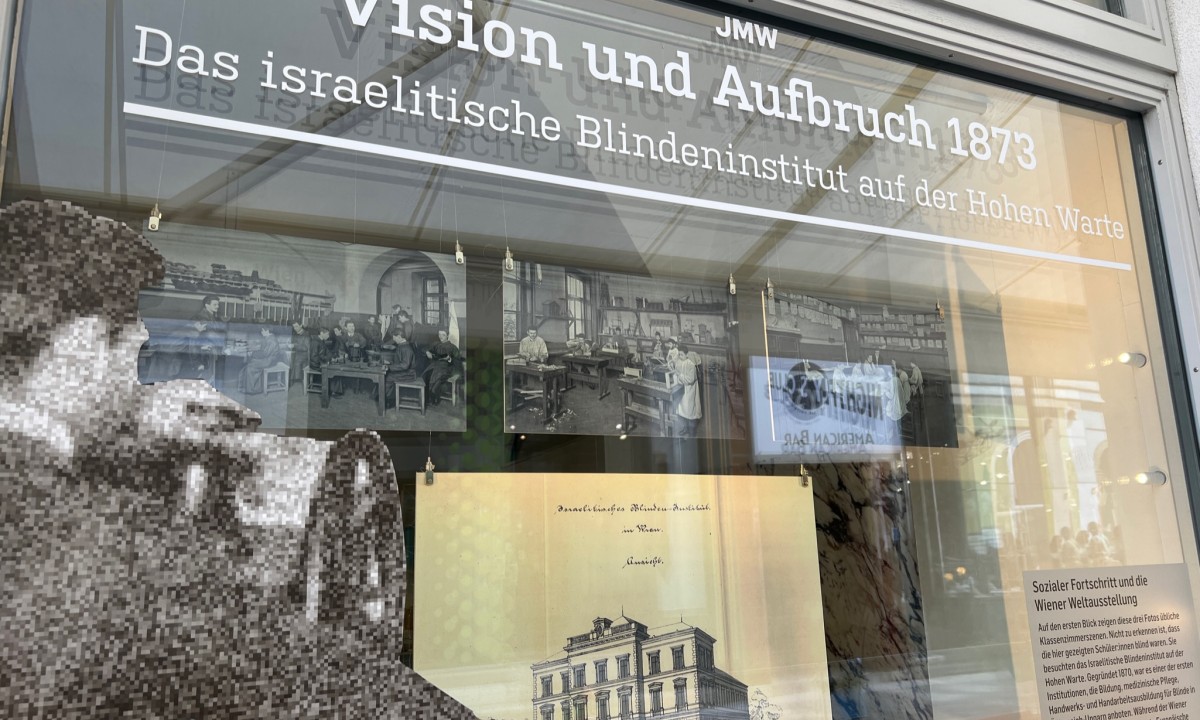150 years ago Vienna served as the world stage; countries from across the globe traveled to the imperial city to put their contributions to technical, cultural, and social progress on display for the 1873 World’s Fair, which ran from May 1 to November 2. Among the exhibiting organizations from the Austro-Hungarian empire was the Israelitisches Blinden-Institut auf der Hohen Warte, established in 1870 under the initiative of Dr. Ludwig August Frankl (1810–1894). Following an illness that nearly cost him his own sight in 1863, it was of great importance to him to establish the Israelite Institute for the Blind in Vienna in partnership with the Israelitische Kultusgemeinde (IKG; Jewish Community of Vienna) (Das Blinden-Institut auf der Hohen Warte bei Wien, 1873, p. 1). To gain insights into the best practices for such institutions, Frankl traveled across the Austro-Hungarian Crownlands and throughout Germany and Switzerland in 1871 (Das Blinden-Institut auf der Hohen Warte bei Wien, 1873, p. 9). At the institute’s grand opening in December 1872, Frankl stated that the number of institutes for the blind a country possesses serves as standard to measure a country’s modern social development. At that moment in time, Austria ranked well below average in this category (Das Blinden-Institut auf der Hohen Warte bei Wien, 1873, p. 14).
Notable members of the Jewish community such as Baron Friedrich von Schey (1815–1881), Baron Anselm von Rothschild (1803–1874), and Baron Jonas von Königswarter (1807–1871) generously contributed to the project. The latter provided the grounds for the institute and tuition for fifty students. This undertaking also found much support beyond the Jewish community as well: Emperor Franz Joseph (1830–1916) and members of the royal family, the mayor of Vienna Cajetan Felder (1814–1894), and several other politicians and non-Jewish citizens made financial contributions. Emperor Franz Joseph also gave the institute a printing press (Das Blinden-Institut auf der Hohen Warte bei Wien, 1873, p. 48). Within the institute’s statutes, a student did not have to be Jewish to attend. The primary requirements were that prospective students should be at least nine years of age upon admittance and be citizens of the Austro-Hungarian Empire (Das Blinden-Institut auf der Hohen Warte bei Wien, 1873, p. 48). International students were also admitted, but were not eligible for financial aid.
06. July 2023
Expo Window
Expo Window No. 2 - Visions and New Beginnings 1873. The Israelite Institute for the Blind
by Caitlin Gura

Photographs taken during lessons for basket weaving, working with iron and carpentry
Photographer unknown
In: Israelitisches Blinden-Institut in Wien. Bericht für die Jahre 1907–1911, Vienna 1912
JMW


Wilhelm Stiassny’s model of the Israelite Institute for the Blind was on display at the World’s Fair. Both the famous Viennese Jewish architect and Frankl received highest honors for their work. According to the Institute’s report from 1875: “The plaster model of the institute building decorated with lithograph plans drew much attention from specialists. The jury awarded the building’s architect Mr. Wilhelm Stiassny with the Medal of Honor and Dr. L. A. Frankl the Medal of Progress for his services to the visually impaired. Both had the honor of presenting the model to their imperial highnesses Archduke Carl Ludwig, protector of the World’s Fair, and Archduke Rainer, president of the aforementioned, and witnessing their exuberant interest," (Israelitisches Blinden-Institut auf der Hohen Warte bei Wien, p. 14). The Israelite Institute for the Blind was a pioneer of inclusion for the visually impaired in Austria-Hungary and perceived its work as an important sign of social inclusion, for the blind as well as Jews. While everyone is afflicted by hardship and illness, sociopolitical power structures differentiate among an individual’s class, religious affiliation, gender, and origin in the provision of care. The Israelite Institute for the Blind, like the Rothschild Hospital that opened in 1873, was open to all and ensured that Jewish patients also received the spiritual care they needed (Das Blinden-Institut auf der Hohen Warte bei Wien, 1873, p. 2).
Inspired by his travels, Frankl organized the first European Congress for the Instruction of the Blind to be held in conjunction with the Vienna World’s Fair. In the preliminary report to the congress, the organizers claimed: “Only through face-to-face communication, the personal exchange of ideas and experiences alone can swiftly and successfully achieve what still needs to be realized in the field of education for the blind, despite many previous achievements. Given how often congresses have taken place in Europe, a congress for directors and teachers from all institutes for the blind has yet to be organized. Therefore it seems not only desirable, but of utmost importance to offer one" (Das Blinden-Institut auf der Hohen Warte bei Wien, 1873, p. 2; translation by the author). Despite Frankl’s failed appeal to the organizers of the World’s Fair to provide them with their own department for blind pedagogy on the fairgrounds in the Prater, the organizers did include the congress in their program calendar (Das Blinden-Institut auf der Hohen Warte bei Wien, 1873, p. 58). From August 3-8, delegations of various European and American institutes met in Vienna to network, exchange best practices, and learn about the latest developments in the field. The City of Vienna and the Imperial and Royal Ministry of Education sponsored the event; the Ministry of Education even provided the ceremonial hall of the Imperial and Royal Academic Gymnasium as event space (Das Blinden-Institut auf der Hohen Warte bei Wien, 1873, p. 58). The congress program included a visit to the Institute at the Hohe Warte in Vienna’s nineteenth district, which was met with much acclaim.
While researching this topic for the Expo Window, a discovery was made within the collections of the Museum of the American Printing House for the Blind (Louisville, Kentucky, USA): a certificate of merit awarded to the American Printing House for the Blind during the Vienna World’s Fair. This discovery illustrates the high level of transnational exchange that took place during this congress, especially at a time when international travel was not as simple as it is today. A major breakthrough at this conference was the acceptance of the six-point Braille script as the official writing system for the blind (website Bundesblindeninstitut Wien). This result helped pave the way for a more accessible society.
Inspired by his travels, Frankl organized the first European Congress for the Instruction of the Blind to be held in conjunction with the Vienna World’s Fair. In the preliminary report to the congress, the organizers claimed: “Only through face-to-face communication, the personal exchange of ideas and experiences alone can swiftly and successfully achieve what still needs to be realized in the field of education for the blind, despite many previous achievements. Given how often congresses have taken place in Europe, a congress for directors and teachers from all institutes for the blind has yet to be organized. Therefore it seems not only desirable, but of utmost importance to offer one" (Das Blinden-Institut auf der Hohen Warte bei Wien, 1873, p. 2; translation by the author). Despite Frankl’s failed appeal to the organizers of the World’s Fair to provide them with their own department for blind pedagogy on the fairgrounds in the Prater, the organizers did include the congress in their program calendar (Das Blinden-Institut auf der Hohen Warte bei Wien, 1873, p. 58). From August 3-8, delegations of various European and American institutes met in Vienna to network, exchange best practices, and learn about the latest developments in the field. The City of Vienna and the Imperial and Royal Ministry of Education sponsored the event; the Ministry of Education even provided the ceremonial hall of the Imperial and Royal Academic Gymnasium as event space (Das Blinden-Institut auf der Hohen Warte bei Wien, 1873, p. 58). The congress program included a visit to the Institute at the Hohe Warte in Vienna’s nineteenth district, which was met with much acclaim.
While researching this topic for the Expo Window, a discovery was made within the collections of the Museum of the American Printing House for the Blind (Louisville, Kentucky, USA): a certificate of merit awarded to the American Printing House for the Blind during the Vienna World’s Fair. This discovery illustrates the high level of transnational exchange that took place during this congress, especially at a time when international travel was not as simple as it is today. A major breakthrough at this conference was the acceptance of the six-point Braille script as the official writing system for the blind (website Bundesblindeninstitut Wien). This result helped pave the way for a more accessible society.
Addendum
This text is available in Braille for visitors at the museum’s ticket counter. The Hilfsgemeinschaft der Blinden und Sehschwachen Österreichs made this possible. Founded in 1935, this organization provides assistance to the blind and visually impaired and works with institutions, like museums, in implementing accessible infrastructure. Inclusion and accessibility are not guaranteed. In a democratic society, it requires the efforts of everyone – each with their own unique, diverse perspective – to work cohesively in enacting and safeguarding the rights of all.
Links
Literature
Das Blinden-Institut auf der Hohen Warte bei Wien. Monographie nebst wissenschaftlichen und biographischen Beiträgen, Wien 1873.
Israelitisches Blinden-Institut auf der Hohen Warte bei Wien. Bericht für die Jahre 1872, 1873, 1874, Wien 1875
Bundesblindeninstitut Wien, „Museum", https://bbi.at/service/museum/ (3.7.2023).

Design for the building of the Israelite Institute for the Blind
Wilhelm Stiassny
In: Das Blinden-Institut auf der Hohen Warte bei Wien, Wien 1873
JMW

Certificate of merit for the American Publishing House for the Blind
Imperial Exhibition Commission
Vienna, 16. August 1873
Courtesy of the Museum of the American Printing House for the Blind
APH Collection, 1991.92

